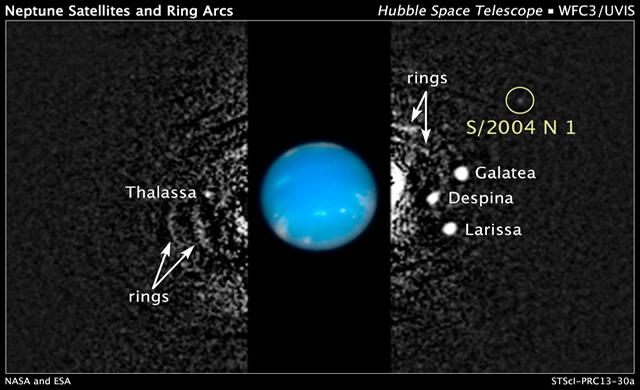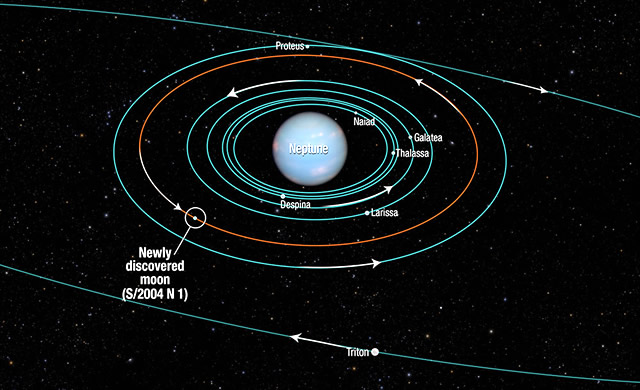
Credit: NASA, ESA, M. Showalter/SETI Institute
La luna, denominata S/2004 N 1, è stimata a non più di 12 km di diametro, che la rende la più piccola luna conosciuta nel sistema nettuniano. E’ così piccola e debole che è circa 100 milioni di volte più debole della stella più debole che può essere vista ad occhio nudo. Ed è anche sfuggita al rilevamento da parte della sonda Voyager 2 della NASA, che ha sorvolato Nettuno in passato, nel 1989, mentre esaminava il sistema del pianeta, delle sue lune e anelli.
Mark Showalter del SETI Institute di Mountain View, in California, ha trovato la luna lo scorso 1 luglio mentre studiava i deboli archi o segmenti di anelli, intorno a Nettuno. “Le lune e gli archi di orbita sono molto rapidi, così abbiamo dovuto trovare un modo per seguire il loro movimento in modo da far risaltare i dettagli del sistema”, ha detto. “E ‘la stesso metodo che usa un fotografo sportivo mentre immortala la traccia di una esecuzione atletica: l’atleta rimane a fuoco, ma lo sfondo sfuma.” Il metodo di monitoraggio ha rivelato il movimento di un puntino bianco che appare più e più volte in più di 150 fotografie d’archivio di Nettuno scattate da Hubble tra il 2004 e il 2009.

Credit: NASA, ESA, and A. Feild (STScI)
The moon, designated S/2004 N 1, is estimated to be no more than 12 miles across, making it the smallest known moon in the Neptunian system. It is so small and dim that it is roughly 100 million times fainter than the faintest star that can be seen with the naked eye. It even escaped detection by NASA’s Voyager 2 spacecraft, which flew past Neptune in 1989 and surveyed the planet’s system of moons and rings.
Mark Showalter of the SETI Institute in Mountain View, Calif., found the moon July 1, while studying the faint arcs, or segments of rings, around Neptune. “The moons and arcs orbit very quickly, so we had to devise a way to follow their motion in order to bring out the details of the system,” he said. “It’s the same reason a sports photographer tracks a running athlete—the athlete stays in focus, but the background blurs.” The method involved tracking the movement of a white dot that appears over and over again in more than 150 archival Neptune photographs taken by Hubble from 2004 to 2009.
Source/Continue reading → Phys.org





















